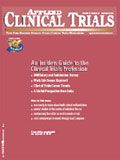First Year For-Profit Finds Big Success
ACR Image Metrix doubles its initial goal for its first fiscal year.
Over a year has gone by since the American College of Radiology (ACR) launched its for-profit division ACR Image Metrix (Philadelphia, PA) in February 2007. And based on its accomplishments thus far, it may be looking at even more success in the foreseeable future.
"We're finding more imaging is being required to get drugs approved," observed Michael Morales, general manager of ACR Image Metrix. And, as imaging becomes more of a necessary —and valuable—requirement of clinical trials, ACR Image Metrix is benefiting from this trend in terms of the business generated from industry, which in turn has allowed it to double its goal of six projects for its first fiscal year.
While the need for imaging is certainly a part of the foundation in which the company's growth has stemmed, ACR Image Metrix was also born into industry with an existing level of credibility due to its sister organizations, the American College of Radiology (ACR) and the ACR Imaging Network (ACRIN).
ACR, founded in 1924, serves its 32,000 members of radiologists, radiation oncologists, medical physicists, interventional radiologists, and nuclear medicine physicians by ensuring safety, accessibility, and efficiency of imaging.
ACRIN is a research organization that was established in 1999. Its trials involve investigators from over 100 medical facilities within the United States as well as some international institutions. It has an archive of over 8 million images and has 180 sites both in and outside the United States, which ACR Image Metrix has access to.
ACR has a core laboratory and three cooperative groups, including ACRIN, the Radiation Therapy Group (RTOG), and Quality Research in Radiation Oncology (QRRO). With an established professional organization and three additional cooperative groups, why might ACR want to launch a for-profit?

Michæl Morales, ACR Image Metrix general manager.
"Government funding goes up and down," Morales explained, "and it might not be there for the future. So, ACR thought maybe we can form a community operation where all profits generated [from ACR Image Metrix] can go back into funding the three cooperative groups."
"We're held internally to high standards because we want to uphold the reputation that the American College of Radiology has built," noted Morales. This solid foundation allows ACR Image Metrix to "tap into its scientific horsepower and its operational horsepower to accomplish what [it] needs to accomplish."
Of the 12 projects begun in the first year, about 60% were global, Morales told Applied Clinical Trials. In order to ensure the most efficiency, images are dealt with electronically, providing a much faster transfer of information.
This electronic transfer takes place through a "proprietary system called Triad that allows sites to download Web-friendly software. Sites can then upload deitemized images with patient data removed. Image Metrix incorporates analysis tools to analyze at a core lab," Morales explained. Thus, "when dealing with images we don't necessarily need someone on site."
About 70% to 80% of the trials exist in the anticancer area, 20% in the musculoskeletal area, and less than 5% in cardiovascular. "There has been an explosion of research in anticancer areas in comparison to other therapeutic areas," noted Morales.
Though anticancer research dominates, Morales expects an increase in the musculoskeletal area simply because more imaging is being required in clinical trials. He also sees potential for the cardiovascular area to increase because ACR Image Metrix is looking to partner with iCAD (Nashua, NH), a provider of computer-aided detection solutions that assist health care professionals in analyzing images.
Exceeding its goals for the first fiscal year, the company is now looking ahead to an even more productive second year. Morales noted, "One of our goals is to add an additional 18 projects and we are at our goal for the first two and half months, so we are on track to attain [it]. Second, we want to be positioned as a market leader in this category...And third, we want to make sure we exceed our clients and sponsors' expectations."—Marissa Shapiro

Improving Relationships and Diversifying the Site Selection Process
April 17th 2025In this episode of the Applied Clinical Trials Podcast, Liz Beatty, co-founder and chief strategy officer, Inato, discusses a number of topics around site engagement including community-based sites, the role of technology in improving site/sponsor relationships, how increased operational costs are impacting the industry, and more.
Behind the Buzz: Why Clinical Research Leaders Flock to SCOPE Summit
February 7th 2025In this episode, we meet with Micah Lieberman, Executive Conference Director for SCOPE Summit (Summit for Clinical Ops Executives) at Cambridge Innovation Institute. We will dive deep into the critical role of collaboration within the clinical research ecosystem. How do we bring together diverse stakeholders—sponsors, CROs, clinical trial tech innovators, suppliers, patients, sites, advocacy organizations, investors, and non-profits—to share best practices in trial design, program planning, innovation, and clinical operations? We’ll explore why it’s vital for thought leaders to step beyond their own organizations and learn from others, exchanging ideas that drive advancements in clinical research. Additionally, we’ll discuss the pivotal role of scientific conferences like SCOPE Summit in fostering these essential connections and collaborations, helping shape the future of clinical trials. Join us as we uncover how collective wisdom and cross-industry partnerships are transforming the landscape of clinical research.